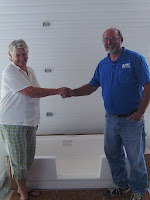 The simple and inexpensive wireless remote many of us use to light holiday decorations can be used to help seniors or people with disabilities in many every day activities. Most of us use these remotes to avoid going out in the cold for our exterior lights or to avoid crawling under the Christmas tree. Imagine for a minute, what life is like for a person who has difficulty handling light switches, phones, tv remotes, or thermostats due to disabilities. What you can accomplish with a tool like the wireless remote then moves from convenience to necessity.
The simple and inexpensive wireless remote many of us use to light holiday decorations can be used to help seniors or people with disabilities in many every day activities. Most of us use these remotes to avoid going out in the cold for our exterior lights or to avoid crawling under the Christmas tree. Imagine for a minute, what life is like for a person who has difficulty handling light switches, phones, tv remotes, or thermostats due to disabilities. What you can accomplish with a tool like the wireless remote then moves from convenience to necessity.Devices very similar to the wireless remote available in hardware stores everywhere for less than $25 could be a powerful life-changing tool. Electronic Aids to Daily Living or EADL are what these devices are called when used by a person with a disability to achieve a greater level of independence at home, school, work, or in recreation. EADL range from the generic and fairly simple, such as devices that use existing household electrical system with plug in receivers and transmitters like X-10 http://www.x10pro.com, to the specialized and often complex devices that operate a wide variety of electric/battery operated equipment such as Quartet technology http://www.qtiusa.com. EADLs enable people to do things like operate emergency call equipment, open doors, operate telephones, control lights, fans, TVs, or audio systems.
A person with very limited physical abilities would benefit from a professional assessment of their goals and skills as well as practice with the equipment in order to make sure they get something that will actually work for them. Not all therapists are experienced in EADL to make these assessments, but we are lucky enough in our area to have some professionals and clinics that do. Give us a call if you are looking for referrals. You can also search the Equipment portion of the Assistive Technology website in Nebrasksa www.at4all.com and the Assistive Technology website in Iowa www.iowacompass.org.
Whatever you do, don’t let the name EADL frighten you away from doing simple, common sense adaptations though. What a powerful safety tool, something as simple as a wireless remote could be for an older person who would like to turn lights on in the path to the bathroom at night.
So share the news and share the video. You can use everyday items like a holiday wireless remote to improve independence and safety for people you love.




+copy.jpg)








